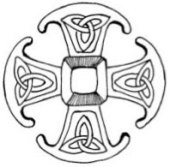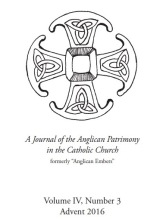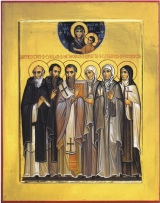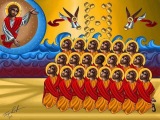At the end of August last year we reported about the Ordinariate exploratory group in Flushing NY who had sadly lost their pastor Dr. Antonio Contreras, who died of a heart attack at 45 years of age. We now learn from Brooklyn’s diocesan newspaper,“The Tablet”, that forty-five members of this group were received into the Catholic Church as an Ordinariate community during the Easter Vigil at St. Michael’s Church in Flushing, where they have been taking part in the Spanish Mass at 1.30 p.m. on Sundays.
This group of 45 (plus five of their children who were baptised the next day) form just a small part of the incredible number of 1,200 Christians who were baptised, confirmed or received into the Church in Brooklyn Diocese this Easter.
The article reads:
Light Shines on Newest Parishioners in Flushing
April 8, 2015
By Ed Wilkinson
Almost 1,200 new Catholics entered the Church last weekend at Easter Vigil services throughout Brooklyn and Queens.
Bishop Nicholas DiMarzio was the main celebrant at St. Michael’s Church, Flushing, where he baptized 18 adults, confirmed those and 28 more and also led a profession of faith by more than 40 Anglicans who came into full communion with the Roman Catholic Church.
The former Anglicans are now members of the Personal Ordinariate of the Chair of St. Peter that was established by Pope Benedict XVI to assist Anglicans who wanted to join the Catholic community.
Not only did 45 Latino Anglicans, former members of St. George’s parish, join the Church, but on Easter morning five of their children were baptized.
Father John Vesey, pastor of St. Michael’s, says his congregation is happy to have these newest members. This weekend, on Divine Mercy Sunday, the parish will host a reception for its newest members following the 1:30 p.m. Mass.
The late Antonio Contreras, their Anglican pastor, was the person who was leading this communal journey to Catholicism. He was going to be ordained a Catholic priest but, unfortunately, he died last summer. Through the encouragement of Msgr. Jeffrey Steenson, a former Anglican bishop who heads the Personal Ordinariate in the U.S., and Father Vesey, the parishioners continued on their journey to full union.
 [The number of catechumens, candidates and former Anglicans at St. Michael’s represents the largest amount of converts to the Church from any one parish in the diocese this year. Father Vesey credits the Holy Spirit but is also quick to praise the work of his associates Father Peter Bai, a native of mainland China, and Father Jaime Hernandez, who is from Colombia, and pastoral associate, Sister Maureen Jessnik, R.S.M., who oversees the work of the RCIA in the parish.
[The number of catechumens, candidates and former Anglicans at St. Michael’s represents the largest amount of converts to the Church from any one parish in the diocese this year. Father Vesey credits the Holy Spirit but is also quick to praise the work of his associates Father Peter Bai, a native of mainland China, and Father Jaime Hernandez, who is from Colombia, and pastoral associate, Sister Maureen Jessnik, R.S.M., who oversees the work of the RCIA in the parish.
“This has been the result of many weeks of preparation, prayer, reflection and living the Christian life,” said Sister Maureen.
“I feel totally different, anew, like I was born again, to be honest,” said Yenny Colon, who received her first sacraments that evening.
Despite the success in Flushing, Father Vesey says the neighborhood is ripe for even more evangelization because of the large number of Chinese and Hispanic immigrants coming to the area that also is showing great economic growth in the Main St. business district, where new banks are opening and most of the billboards are in Chinese.
At the Vigil, Father Vesey challenged the parish to raise the number of Chinese converts to 500 next Easter and the Hispanic community to recruit 1,000 more parishioners.
“You just do the work,” Bishop DiMarzio told Father Vesey. “The Holy Spirit will provide the numbers.”
Father Vesey has urged that parishioners financially support the work of the Church, pray and work for more home-grown vocations and stimulate youth ministry in the parish.
“This is a very pious, very good community,” adds Father Vesey.
Following the Vigil, Bishop DiMarzio met with a group of young parish leaders to encourage them to continue to build up the local Church.
With the Easter Vigil done, the Christian symbols of light piercing the darkness of a church, the bells ringing and alleluias being sung, loudly proclaimed in Flushing that Jesus had risen from the dead and it was Good News indeed.











Great news, and great to get “closure” on a story which attracted so much interest last summer. I would also put this forward as an illustration of the fact that the Church is not shy about publicising receptions into the Ordinariate.
Dear EPMS,
Personally I would hesitate to use a word like “closure”. A careful study of the report and the accompanying photos would seem to indicate that no Ordinariate priest was present at the reception, No Ordinariate pastor or catechist is mentioned in the text. The Ordinariate group still take part in the second parish Spanish Mass at 1.30 p.m. No mention is made of special liturgical, or any other kind of provision for this community. So my fear is that here we have another community of Ordinariate laypeople having to fend for themselves in the State of New York (alongside Rochester), and in the case of this fledgling group the danger that they will lose their identity and just be assimilated into an obviously thriving Latino parish seems to me to be great.
What is going to keep this group together if they have no Hispanic former Anglican pastor? What is the Anglican patrimony of Latino Anglicans? I don’t know, to be truthful.
David Murphy
Yes, your last question is a valid one. There is no Spanish Ordinariate Rite. My Spanish is not up to the task of discerning how “Anglican” the Libro de Oracion Comun is, in any event. I would imagine that the hymns at San Jorge are not sung to Cwm Rhondda and Repton. This article http://www.latinopost.com/articles/1122/20131120/the-latin-wave-in-the-anglican-church-latino-hispanic-episcopal.htm. concerns parishes in Texas but I have read that most Spanish-language Episcopal parishes throughout Canada and the US also have a significant number of former Catholics among their congregants. Indeed both the late Antonio Contreras and OCSP priest Fr Gonzalez y Perez came from Catholic families. So it is reasonable to assume that some of the forty former San Jorge parishioners were in fact being reconciled with the Church. So will their “Anglican patrimony” have any lasting existence at St Michael’s? As you say, the article does not identify any means by which this might be effected, but perhaps the OCSP will comment somewhere.
EPMS,
You wrote: There is no Spanish Ordinariate Rite.
Yes, but there are now three Spanish-speaking congregations within the Personal Ordinariate of the Chair of St. Peter — certainly enough to demonstrate a clear need for a Spanish translation of the Divine Worship liturgy.
You wrote: … I have read that most Spanish-language Episcopal parishes throughout Canada and the US also have a significant number of former Catholics among their congregants.
So do many English-speaking parishes of The Episcopal Church (TEC).
You wrote: So will their “Anglican patrimony” have any lasting existence at St Michael’s? As you say, the article does not identify any means by which this might be effected, but perhaps the OCSP will comment somewhere.
With 45 members, they certainly have enough “critical mass” to sustain a distinct community.
And no, the ordinariate won’t comment. The ordinary will appoint a pastor for this community sooner or later, but probably with little fanfare.
Norm.
I see that St Michael’s, Flushing has a new website. The latest parish bulletin http://nebula.wsimg.com/70f07e5cd5afab70cd8f58f9557eb779?AccessKeyId=E747816F84C681AD33D9&disposition=0&alloworigin=1
has no reference to any distinct community within the parish, which would suggest that the group has simply integrated into the existing 1:30 Spanish mass.
Why with little fanfare? When Fr Catania was appointed to St Edmund’s, Kitchener, previously ministered to by a diocesan priest, this was widely reported.
PS More important point, I guess, is what would be “distinct” about this community?
EPMS,
You asked: PS More important point, I guess, is what would be “distinct” about this community?
For starters, their common heritage as Spanish-speaking Anglicans, their existing bonds of community and fellowship, and their canonical affiliation with the Personal Ordinariate of the Chair of St. Peter rather than the local diocese.
But there are other elements of their tradition that they can maintain, even if according to the Spanish translation of the Roman Rite: morning prayer (lauds), evensong (or vespers), etc. It’s likely that they also celebrate the festivals of certain saints with greater festivity and even solemnity than the local diocesan parishes.
Norm.
The question was “what IS the ‘common heritage’ of Spanish-speaking Anglicans”? Evensong and Morning Prayer do not seem to be a feature of their previous Episcopal parish. Perhaps they have experienced these elsewhere, but I wouldn’t count on it. The saints question is interesting, although I do not see, say, Bl John Henry Newman or St Cuthbert being a draw here, but what do I know? “Canonical affiliation” does not strike me as a basis of community in the absence of any other elements of culture. So the real source of community would be, as Norm puts it “their existing bonds of community and fellowship.” If this is a coherent social group they may wish, ultimately, to worship separately and conduct their own program of parish life. This seems to be the pattern of some of the leaderless OOLW groups who are worshipping in the OF at diocesan parishes but nonetheless get together for their own coffee hour, etc. The only drawback here is that there is nothing to draw newcomers into that circle, so the group fails to grow. If the social bonds are not strong among these former Episcopalians no doubt they will merge into the larger parish.
I too am not overly optimistic if this question is not addressed urgently, with a full-time Hispanic pastor and a swift definition of what makes up the patrimony of this community.
David
http://www.npr.org/2012/09/11/160011671/episcopal-church-woos-latinos-to-congregations
Another possibly relevant article.
“The broader Episcopal Church itself notes that the similarity to Catholic services is one of the selling points for Latinos”
Interesting.
godfrey1099,
You wrote: “The broader Episcopal Church itself notes that the similarity to Catholic services is one of the selling points for Latinos”
Interesting.
Ey-yup!
“They went out from us, but they did not really belong to us. For if they had belonged to us, they would have remained with us; but their going showed that none of them belonged to us.” — I John 2:19.
Norm.
Is the point that they were never really Episcopalians? (slightly amended by Editor)
EPMS,
You wrote: Is the point that they were never really Episcopalians?
*LOL*
Touché!
The point was about those who left the Catholic Church, but it certainly also is true that those leaving The Episcopal Church (TEC) to come into the ordinariate never ascribed to the present beliefs and practices of that body.
Those who leave the Catholic Church, form a relationship with our Lord in another (usually evangelical Protestant) body, and then come back to the Catholic Church typically become real Catholics for the first time.
Norm.